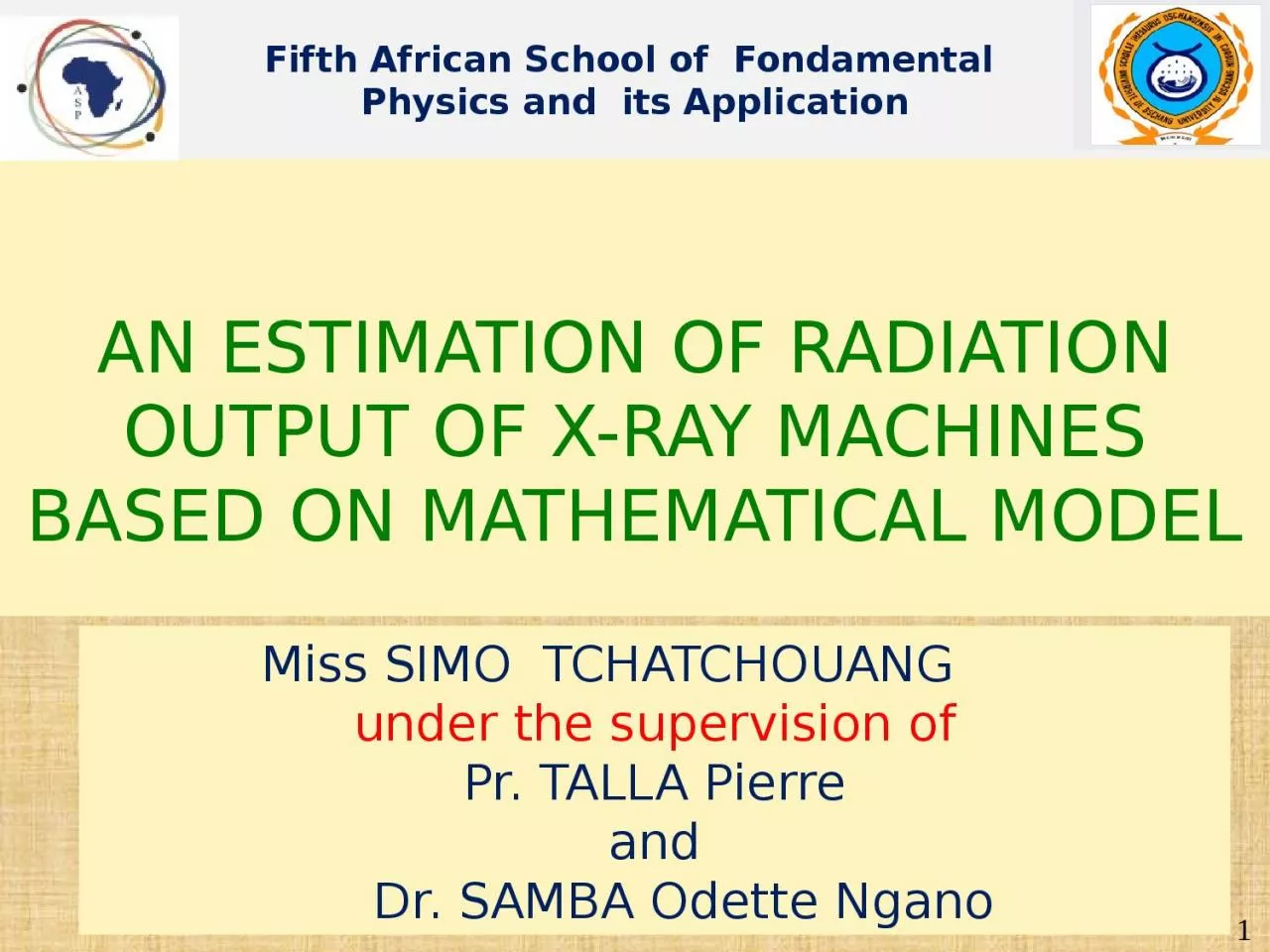

Miss SIMO TCHATCHOUANG under the supervision of Pr TALLA Pierre and Dr SAMBA Odette Ngano Fifth African School of Fondamental P hysics and its Application ID: 932614
Download Presentation The PPT/PDF document "AN ESTIMATION OF RADIATION OUTPUT OF X-R..." is the property of its rightful owner. Permission is granted to download and print the materials on this web site for personal, non-commercial use only, and to display it on your personal computer provided you do not modify the materials and that you retain all copyright notices contained in the materials. By downloading content from our website, you accept the terms of this agreement.
Slide1
AN ESTIMATION OF RADIATION OUTPUT OF X-RAY MACHINES BASED ON MATHEMATICAL MODEL
Miss SIMO TCHATCHOUANG under the supervision ofPr. TALLA Pierreand Dr. SAMBA Odette Ngano
Fifth African School of Fondamental Physics and its Application
1
Slide2GENERAL INTRODUCTION I: REVIEW
OUTLINES II:
MATERIALS AND METHODS
III
:
RESULTS AND DISCUSSIONS
GENERAL CONCLUSION AND PERSPECTIVES.
2
Slide33General introduction
Radiology is widely used for diagnostic and therapeutic purposes. But the use of x-rays in the medical domain in not only beneficial. Erythema
Dry desquamationsCancerThe ESAK is defined by the
IAEA
as the absorbed dose to the air at the point of intersection of x-ray beam axis with the entrance surface of the patient, including backscattered radiation from the patient
.
Slide4General introduction
Materials needed for dose measurements: Thermoluminescent Dosimeters (TLD)Ionosing chambers (IC)Alternate methods to the use of
dosimeters for dose estimation: Mathematical EquationsLimitationNeed of a dosimeter to mesure the radiation output or air Kerma4objective
Propose a mathematical model to estimate radiation output of three phases x-ray machines
Slide5Methods for evaluation of the ESAK in conventional radiology
Davies model
:
(1)
output of the x-ray machine
Backscatter factor
5
Voltage
Focus skin distance
Slide6Methods for evaluation of the Kerma in conventional radiology
Harppen’s
model :
Sunchart Cotran and Montree’s equation for estimating the Radiation output
(2)
(3)
6
Slide7Materials
Fig. 1: x-ray machine
Fig. 2: Diavolt7A total number of four Three phases x-ray machines were used
Slide8fixed parameters : The charge: 20mAs
The FDD: 1mThe anode angle:Method
variable parameters:
Tube voltage from 60-120kv by interval of 10
Filtration
8
Slide9Methods
(4)
Defined Model9
Slide10Results and Discussions
Table 1: Specific data of machines
MachinesEquipment ModelDate of manufacture
Date of installation
Total filtration
At 80
Kv
Total filtration
Used During Measurements
1
General Electric Healthcare
2011
2012
2,5mm Al
2,5
2
General Medical Merate
2014
2015
2,9 mm Al
3
3
Siemmens
2003
2004
3,6 mm Al
4
4
Stephanix
……………….
…………….
3
3
10
Slide11Results and Discussions
Table 2: Results of the measurements done for the first machine .
Fixed kV60
70
80
90
100
110
Mean
kVpmax
70.57
77.00
87.53
99.80
129.37
15.571
Mean dose (µ
Gy
)
437.83
633.57
855.40
1105
1394
1734.67
Mean dose (µ
Gy
/
mAs
)
21.89
31.68
42.77
55.25
69.70
86.73
T
able
3
:
Results of the measurements done for the second machine
.
Fixed
Kv
60
70
80
90
100
110
120
Mean
kVpmax
66.96
75.5
86.2
96.2
116.03
134.48
134.9
Mean dose(µ
Gy
)
536.43
772.16
1034
1312.3
1648.6
2164.5
2302
Mean dose (µ
Gy
/
mAs
)
26.82
38.60
51.7
65.61
82.43
101.35
115.1
11
Slide12Results and Discussions
Table 4: Results of the measurements done for the third machine
Fixed kV60
70
81
90
102
113
121
Mean
kVpmax
54.36
69.76
85
87.23
93.46
99.83
997
Mean dose(µ
Gy
)
527.46
724.06
937.83
1136.6
1384.6
1683
1760
Mean dose (µ
Gy
/
mAs
)
26.37
36.20
46.89
56.83
69.23
80.26
88.03
Table
5
:
Results of the measurements done for the fourth machine
Fixed KV
60
70
80
90
100
110
Mean
KVpmax
58.2
68.2
78,6
88,8
99,1
111,7
Mean dose(µGy)
523
731.7
979.1
1241
1508,3
1790,6
Mean dose (µ
Gy
/
mAs
)
26,15
36,58
48,95
62,05
75,41
89,53
12
Slide13Results and Discussions
DIRIVED EQUATION FOR OUTPUT
T is the total filtration which includes the inherent and the added filtration of tree phases x-ray machine(4)13
Slide14Comparison of results
14Graph 1: Comparison between the measured and calculated outputGraph 2: Relative deviation between measured an estimated output
Slide15Comparison of results15
Graph 3: Comparison of relative deviation between the Suchart’s model and our defined modelGraph 4: Relative deviation according to the Suchart and Montree’s model and our defined model for another device
Slide16This study provided an equation to estimate radiation output for three phases x-ray machines in the case of non-availability of dosimeters
Conclusion The results also shows that taking into account the filtration, our model performs better than the Suchart and Montree’s model
A comparison between the results obtained from our model and those from measurements shows that the difference between both quite small.16
Slide17To compare the result of ESAK calculated using our model with those from TLD
PerspectivesTo extend the study to others types of x-ray machines: single phase and high frequency
Include the distance as a variable parameter in the model17
Slide18THANKS FOR
YOUR ATTENTION Thanks
to all 18